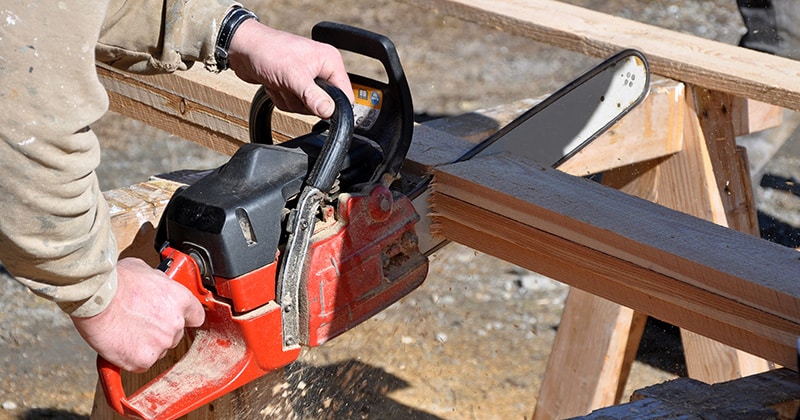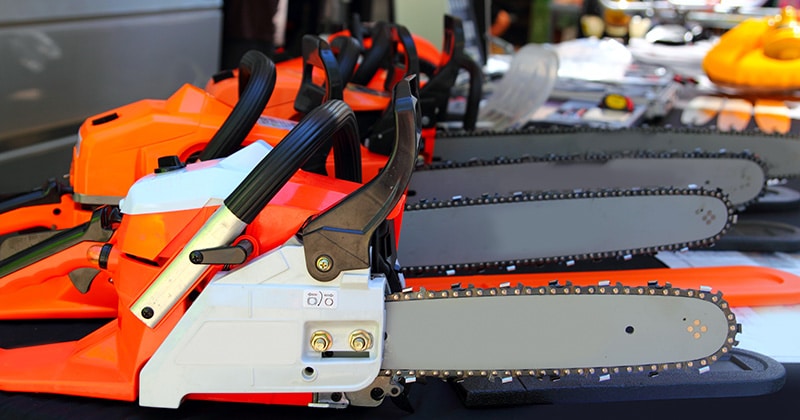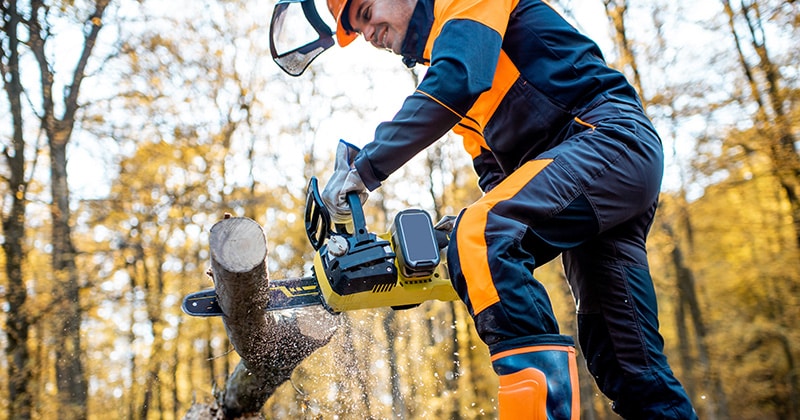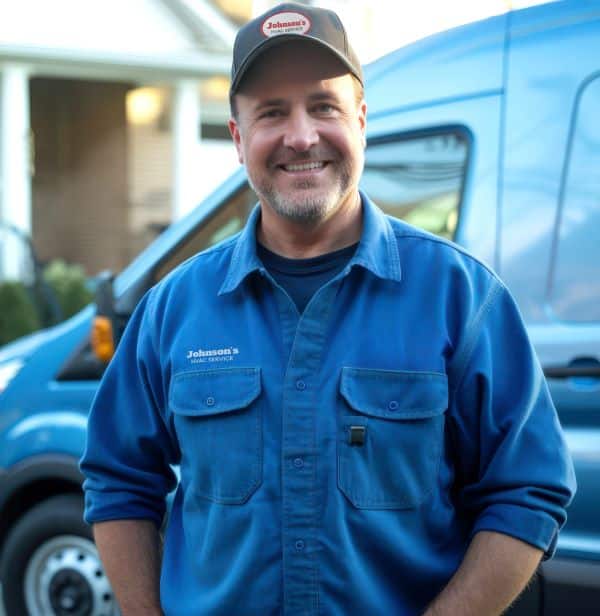The 8 Top Commercial Chainsaws
When you need a powerful tool that can quickly cut bushes, trees, or wood, you’ll need a commercial chainsaw. With many choices for professionals, use this guide to compare options.

Staff Contributor
When cutting wood professionally, whether tree limbs or two-by-fours, the tool you use impacts efficiency and performance. A commercial chainsaw should be able to stand up to the demands of these activities. Researching chainsaws can be overwhelming, with so many options available from leading manufacturers.
In this guide, you’ll learn why professionals need a high-quality commercial chainsaw, the top features to seek out, and the best products available to fit your needs.
Why Pros Need a High-Quality Commercial Chainsaw
As with any equipment your company uses to tackle big jobs, a commercial chainsaw will need to be high-quality and designed for heavy-duty use. When you have a reliable, professional chainsaw, you can ensure that it gets the job done well and has the capacity to handle constant use.
Purchasing a commercial-grade chainsaw may improve worker performance. Greater efficiency is often an outcome because your workers won’t have to limit the use of the machine. A standard chainsaw may only have enough power to do small cuts.
Using high-quality chainsaws designed for commercial use can also increase productivity. When cutting is fast and requires less exertion by the operator, you and your workers can get more done in a shorter time frame.
So, who needs a commercial chainsaw?
There are many home services companies and industries that can benefit from this tool, including:
- Landscaping: Make quick work of jobs that involve trimming larger limbs or complete removals of dead trees. Landscaping employees will appreciate having reliable equipment.
- Professional forestry and arborists: Overseeing forest land also means keeping it healthy and safe. A commercial chainsaw will be essential for storm cleanup and removal of fallen trees.
- Construction: Part of the construction of new homes or buildings may include clearing land. If that’s part of the project, your workers will need robust chainsaws to remove plants and trees.
- Firefighters: When dealing with brush and wildfires, firefighters rely on chainsaws to cut firebreaks to stop the spread. In this extreme environment, having one that is commercial-grade can make a big difference in doing this work quickly.
- Wood and ice sculpting: Highly skilled artists who shape wood and ice into sculptures use chainsaws in the creation process. With constant use and the need for precise performance, this group would also be a prime user of commercial chainsaws.
Commercial chainsaws are essential in many industries, helping workers trim, cut, and saw faster and more adeptly.

Factors to Consider When Choosing a Commercial Chainsaw
Searching for a commercial chainsaw for your business should include defining the factors that will influence your decision.
Let’s review important factors to consider when evaluating commercial chainsaws.
Power and Engine Type
The power and engine type of the chainsaw determines its robustness and usability. You’ll be looking at:
- Power measured by cc (cubic centimeters), which defines the engine size
- Horsepower (engine output)
- Torque (the twisting or rotational force)
- Power speed in rpm (revolutions per minute)
- Gas-fueled (typically two-stroke) or battery-powered (electrical charging)
Bar Length and Cutting Capacity
The next consideration when purchasing a chainsaw for commercial use is its bar length and cutting capacity. The length of the bar is just as critical as the power behind it.
A long bar, driven by a robust engine, will have the ability to make one pass through a large tree. If your jobs often involve removing bigger trees or limbs, you’ll want a long bar. A longer bar may speed up the project, so you can invoice a landscaping job sooner and collect payment.
Smaller bars are more precise and can manage quick, minor cuts.
Depending on how you use the commercial chainsaw, you may need a long bar, a short bar, or both.
Cutting capacity refers to how well a chainsaw performs its essential functions of slicing through wood. How much it can cut ties into the operator’s productivity. A higher cutting capacity equals greater work efficiency.
The measurement of cutting capacity is cm2/s, which is the cross-cutting area per unit of time (seconds). These calculations assess the amount of time required to cut through a piece of wood at its highest speed.
Bar length and cutting capacity directly impact productivity and efficiency. Comparing products based on these factors will help you in making a final decision.
Durability and Build Quality
A commercial chainsaw must endure constant use and sometimes harsh environments. Thus, it must be durable, and the build must be of high quality.
What makes a chainsaw durable? A big part of this is the quality of its steel components. When it’s high-grade, the build is stout and will last longer. Commercial chainsaws typically have this higher grade versus standard, non-professional use equipment.
Another part of reliability relates to the chains and their resiliency. You can sharpen chains when teeth wear down, but how often they need it depends on:
- The quality of the steel used in the teeth
- The rust resistance of the chain
- Bumper spike makeup (stainless steel is best)
Safety Features
You can’t leave out safety when evaluating chainsaws for your business. You want to keep workers safe at all times. The chain break design will be a primary factor in worker safety. Other factors include kickback guards, vibration reduction, and enhanced controls.
The operator user experience will also impact how safe it is. The chainsaw should be easy to handle, lightweight, ergonomic, and within the compliant range for noise.
Making chainsaw safety features a part of your review process can also minimize any liability concerns. While no piece of equipment can be risk-free, purchasing chainsaws that innovate in this area offers safety benefits.
Cost and Value
A professional chainsaw costs more than one for light use. That’s because it uses higher-grade materials for durability and longevity.
Investing in the best equipment for your business often means paying a premium. You need to consider the total cost of ownership (e.g., maintenance, fuel) and the estimated useful life to determine value.
A cheaper chainsaw may only last two years, while a more expensive option could last four. You also have to consider all the features that make the machine more efficient. Greater engine power will cost more, but it may shave hours off of a job, enabling you to complete more jobs in one day.
What tools you invest in will also impact your pricing for customers. You should always consider this when creating quotes. It’s not just the labor they are buying but also the “use” of your equipment.

Essential Features to Look for in Commercial Chainsaws
The decision-making process for buying equipment always includes the features available. Each of these capabilities will affect what products you choose. So, what features matter most in commercial chainsaws?
Add these to your criteria when researching commercial chainsaws:
Anti-Vibration Systems
An anti-vibration system minimizes impact and operator fatigue that can occur with extended usage. Anti-vibration systems have been part of chainsaws for over 50 years and have evolved as technology has. This feature allows the equipment to absorb the shock.
Advanced solutions include components for:
- Decoupling the device handle from the drive train
- Buffer and spring elements, which can consist of rubber, steel, or both
- Meeting compliance with occupational health and safety guidelines
Keep in mind that anti-vibration systems can isolate the pulsing; they may have a negative impact on how you handle the device.
Maintenance Features
All equipment requires regular and consistent maintenance to ensure it has a long life. Some chainsaws have added maintenance features, which makes upkeep easier.
Typical maintenance activities include:
- Cleaning the air filter: If it’s a quick-release air filter, it’s easier to do this.
- Sharpening chains: Understand how accessible the chains are to determine the ease of sharpening.
- Checking chain tension: Side-mounted chain tensioners are more convenient for making quick chain adjustments.
- Ensuring bar and chain oil reserves are full: Review if a model is easy to lubricate.
Ergonomic Design and Comfort
The ergonomics of a chainsaw design are another critical feature for worker safety and comfort. First, the handle should be ergonomic, with a comfortable grip that also stabilizes control.
Second, it should feel balanced in your hands. The cut should be straight and not create a twisting motion. Being able to rock the saw backward and forward is a sign of good balance.
Third, the weight of the machine also affects the user. A lightweight option is crucial for prolonged use and doesn’t need to reduce its power.
The fourth consideration in ergonomics is trigger comfort. Most commercial chainsaw triggers allow for two fingers, and some have even more space. An ideal trigger will retract flush rather than a raised bump that fingers must push against.
Chain Break Mechanisms
The chain break mechanism is part of the front handguard. When engaged, the chain breaks to prevent spinning. In an emergency condition, the chain break feature needs to be easy to activate.
Once it is, the chain rotation stops immediately. Some models have a throttle lockout lever in addition to the chain breaking feature.
Handle Position
A chainsaw can have a front or rear handle. Most professional models are rear-handled since workers usually need their feet on the ground.
A top handle, however, may be more beneficial if cutting while standing on a ladder or in a tree. Often, commercial users will have both options available, depending on the job type.

The 8 Top Commercial Chainsaws for Professionals
In creating this list, we considered many things, including brand reputation, performance, durability, operator comfort, user reviews, portability, and efficiency.
Here are the top choices for commercial chainsaws:
1. Husqvarna 460 Rancher
The Husqvarna 460 Rancher comes from a well-respected brand and is feature-rich.
Features
- Smart start system
- LowVib technology for vibration control
- Side-mounted chain tensioner
- Choke/stop control
- 3.62 hp X-Torq engine
- 1.4 Nm torque at 7,000 rpm
- 24-in bar
Benefits
- It has a powerful engine, which makes it ideal for tough cutting jobs.
- The model uses less fuel consumption and has reduced emissions.
- Its 24-in bar works effectively on large trees and logs.
- Reduced vibrations and ergonomic handles support worker comfort.
- Its Air Injection™ technology keeps filters cleaner for longer.
Cons
- It’s heavier than many options at nearly 13 lb.
- The cost may be outside of many budgets, with a retail price of $499.
The manufacturer’s website lists numerous reviews. The average star rating is 4.5 out of 5.
2. STIHL MS-291
The STIHL MS-291 boasts fuel efficiency and dependability.
Features
- 3.76 hp engine
- 18-in bar length
- Pre-separation air filtration system
- Anti-vibration system
- Bumper spikes
- Spark arrester muffler
- Side-access chain tensioner
Benefits
- A single lever operates the choke, starting throttle lock, and the on/off switch.
- It features high-tech polymer housing that’s corrosion-resistant and can withstand greater impacts.
- The 3.76 hp engine ensures you’ll have the power you need for commercial work.
- Large baffles decrease noise levels and house screens that reduce emission sparks.
Cons
- The bar length is smaller at only 18 in.
- While it’s fuel-efficient, it doesn’t have any lower emission qualities.
3. ECHO DCS-2500T
The ECHO DCS-2500T has a superior power-to-weight ratio compared to its competitors. It’s a top-handle, battery-power option.
Features
- ECHO eFORCE® 56 V battery
- Brushless motor
- Quickdraw harness ring for secure access
- Rapid or standard chargers
- 12-in bar
Benefits
- You’ll save on gas costs with a battery-powered option.
- It uses MAXOUT™ technology to enable maximum power output throughout the battery’s charge.
- It’s lightweight, only 7.3 lb, and maneuvers well in trees.
Cons
- Its battery life is approximately 60 cuts and requires at least 38 minutes to charge.
- The bar length is only 12 in, so it may not have the capacity to manage larger cuts.
The manufacturer’s website includes many reviews, garnering 4.6 out of 5 stars. Users said it was lightweight and powerful.
4. FARMMAC F660VW
The FARMMAC F660VW makes the list with a 92 cc 2-cycle gas engine.
Features
- Air-cooled engine
- 36-in bar
- High-quality spark plugs
- Magnesium alloy body composition
Benefits
- This model is lightweight but has a robust engine and one of the longest bars.
- The spark plug upgrade ensures quick ignitions and surging power.
- Its material makes it extremely durable and great for harsh conditions.
Cons
- Such power and features come with a higher price tag.
- Since it’s larger, it weighs more at 18.18 lb.
5. OREGON CS1500
The OREGON CS1500 is electric-powered and has self-sharpening abilities.
Features
- Rear-handled
- Corded electric power source
- 18-in bar length
- Chain break
- Automatic lubrication
Benefits
- Since the chainsaw is electric, there’s much less noise.
- Toolless tensioning allows you to make adjustments by tightening the side cover ring.
- A pull of a lever sharpens the chain in five seconds or less.
Cons
- A corded chainsaw limits usability.
- It’s on the heavier side, weighing in at 17 lb.
6. BILT HARD 20 Inch Gas Chainsaw
The BILT HARD 20-in professional chainsaw is versatile, supporting tree felling, limb trimming, and lighter yard work.
Features
- 60 cc 3 hp 2-stroke engine
- 20-in bar
- Top-handled
- Bumper spike
Benefits
- Its high-quality carburetor enables operational efficiency and supports a longer lifespan.
- The low kickback function enhances safety.
- An air cleaning system improves engine performance.
- The package includes a 2-cycle engine oil, lubricating bar and chain oil, a tool kit, and safety goggles.
Cons
- Its noise level is greater than others, as reviews indicate.
- Users also recommended a softer pull-start handle.
7. CRAFTSMAN 2-Cycle Gas Chainsaw
This CRAFTSMAN 2-cycle chainsaw comes from a brand that is well-known for this equipment. It rates well for performance, power, and ease of use.
Features
- 42 cc full-crank, high-output engine
- 16-in bar
- 3-point anti-vibration system
- EasyStart technology
- Adjustable automatic chain oiler
Benefits
- Maintenance is straightforward and requires no tools to access the filter or spark plugs.
- Bucking spikes create greater leverage for more controlled motions.
- The inertia-activated chain break stops it automatically.
Cons
- It can work well on many jobs but isn’t powerful enough for massive logs.
- The 16-in bar may also limit its usability on certain jobs.
8. STIHL MS 881 MAGNUM®
The STIHL MS 881 MAGNUM is the brand’s largest and most powerful chainsaw.
Features
- 8.6 hp engine
- 25-in bar
- Washable air filter
- Bumper spike
- Adjustable automatic oiler
- Decompression valves
- Side-access chain tensioner
- Anti-vibration system
Benefits
- Tackle any job with its up to 41-in guide bar length and robust engine.
- The ElastoStart™ starter handle has a built-in shock absorber that reduces sudden forces or compression peaks.
- The IntelliCarb™ Compensating Carburetor automatically adjusts air/fuel ratios if air filters clog or become restricted.
Cons
- This massive tool retails at $2,299, making it the most expensive on the list.
- The STIHL MS 881 is also heavy at nearly 22 lb.
This option has many positive reviews from buyers, scoring 4.8 out of 5 stars. They gave it high marks for quality, dependability, power, and value.
6 Takeaway Tips for Choosing a Commercial Chainsaw
-
Watch videos of all the top commercial chainsaws to understand how they perform in terms of power, cutting capacity, and operator comfort.
-
Determine how features and considerations impact your specific use cases to narrow down the biggest priorities for your purchases.
-
Get feedback from your workers, peers, and other experts on what professional chainsaw brands and models they use and like.
-
Define your budget for this tool purchase, considering how many chainsaws you need, their expected lifespan, maintenance, and the cost of the equipment.
-
Visit dealers that carry commercial chainsaws to see options in person and try them out.
-
Decide on which power source is right for your needs—gas or battery—as the starting point for choosing a new commercial chainsaw.
Beckie likes words! Whether she’s creating content or working on the shortest of short stories, she’s always thinking about craft. In her downtime, she contributes to her mission of filling up her camera roll with as many photos of her cats as possible. They hate it.

Business Solutions For Field Service Pros
EverPro offers specialized solutions designed for home and field service professionals. We’ve got the business tools to help you get the job done.



